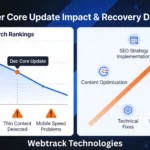The world of web development is vast, with various roles and specializations. Among these, front end developers play a crucial role in shaping the user experience by building the visual and interactive aspects of a website or web application. This blog post delves into the key skills and responsibilities of a front end developer, highlighting what makes this role indispensable in the digital landscape.
What is a Front End Developer?
A front end developer is responsible for implementing the visual elements of a website or web application that users interact with directly. They work closely with designers to bring mockups and wireframes to life, ensuring that the final product is both functional and aesthetically pleasing.
It’s useful to simplify the differences between different developer positions like follows in order to clarify them:
Front End Developer: This specialist works on the visible and interactive parts of a website or application that people interact with directly.
Back-End Developers: They are responsible for overseeing the “behind-the-scenes” operations that allow an application to function properly, such as databases and infrastructure.
Full Stack Developer: This adaptable expert has a wider range of abilities and is capable of managing the whole design process from start to finish. They are skilled in both back-end and front-end programming.
Front End Developer Skills
To excel in their role, front end developers need to master a variety of technical and soft skills:
HTML/CSS: The foundation of web development, HTML (HyperText Markup Language) and CSS (Cascading Style Sheets) are essential for creating and styling web pages. HTML provides the structure, while CSS handles the design and layout.
JavaScript: This programming language allows developers to add interactivity to websites. From simple animations to complex web applications, JavaScript is vital for enhancing user experience.
Responsive Design: With the increasing use of mobile devices, it’s crucial to ensure websites are accessible and functional across various screen sizes and resolutions. Front end developers must be adept at creating responsive designs.
Frameworks and Libraries: Knowledge of frameworks like React, Angular, and Vue.js, as well as libraries like jQuery, can significantly speed up development processes and add robust functionality to web applications.
Version Control/Git: Collaboration and version control are critical in web development projects. Familiarity with Git allows developers to track changes, collaborate with team members, and manage code effectively.
Cross-Browser Compatibility: Ensuring that a website works seamlessly across different browsers (e.g., Chrome, Firefox, Safari, Edge) is a key responsibility. Developers must test and debug code to achieve this compatibility.
Performance Optimization: Front end developers should be skilled in optimizing website performance, including minimizing load times and ensuring smooth functionality. Techniques like lazy loading, minification, and caching are often employed.
API Integration: Integrating with various APIs (Application Programming Interfaces) to fetch and display data from external sources.
Basic Understanding of Back End: While primarily focused on the client side, having a basic understanding of back end technologies (like databases and server-side scripting) can help in integrating front end and back end seamlessly.
Soft Skills: Communication, problem-solving, and attention to detail are crucial for front end developers. They often need to collaborate with designers, back end developers, and other stakeholders to deliver a cohesive product.
Front End Developer Roles and Responsibilities
An essential component of web development is front end programming. Their important responsibility is to design the user interface and experience of websites and web applications. The responsibilities of a front end developer can vary depending on the project and organization, but some common duties include:
User Interface (UI) Design: To convert wireframes and design mockups into usable web pages, front end developers work closely with UI/UX designers. They are in charge of making sure the visual design components are applied accurately.
Translating Designs into Code: Working with designers to transform design mockups into functional web pages using HTML, CSS, and JavaScript.
Ensuring User-Friendly Interfaces: Creating intuitive and responsive interfaces that provide an excellent user experience across devices.
Testing and Debugging: Identifying and fixing bugs, ensuring cross-browser compatibility, and conducting usability testing to iron out any issues.
Optimizing Performance: Implementing best practices for speed and performance, such as image optimization, code minification, and efficient loading techniques.
Front End Frameworks and Libraries: To speed up development and improve user interaction, they frequently collaborate with front end frameworks and libraries like React, Angular, or Vue.js.
Version Control: To keep track of changes, work with other developers, and preserve codebase integrity, one must be proficient with version control systems such as Git.
Troubleshooting and Debugging: One of the most important tasks is locating and resolving front end problems, such as broken links, layout flaws, or JavaScript failures.
Staying Updated: Keeping up with the latest trends, tools, and technologies in front end development to continuously improve skills and deliver cutting-edge solutions.
Collaborating with Team Members: Working closely with designers, back end developers, and other team members to ensure a seamless integration of front end and back end components.
Maintaining Code Quality: Writing clean, maintainable code and adhering to best practices in web development.
How to Become a Front End Developer?
Learn the Basics of Web Development
Start with the foundational technologies that every front end developer needs to know:
1.HTML
2.CSS
3.JavaScript
These are the core technologies used in front end development.
Build Your First Web Projects
Put your knowledge into practice by building simple web projects. Start with a personal portfolio website or recreate a popular website’s layout. Hands-on experience is the best way to solidify your understanding of HTML, CSS, and JavaScript.
Develop a Development Environment
- Install code editors to write and organize your code, such as Atom or VS Code.
- Learn how to use code management version control systems, such as Git.
Explore Advanced Topics and Tools
Proficiency of JavaScript
- Start by learning about variables, data types, functions, and control structures in JavaScript.
- Go on to more complex subjects including event management, AJAX, asynchronous programming, and DOM manipulation.
- Examine contemporary JavaScript frameworks and libraries such as Vue, Angular, and React.js
Responsive Web Design
- Understand how to use CSS frameworks like Bootstrap and CSS Grid to create responsive layouts.
- Recognize viewport meta tags and media queries to guarantee cross-device compatibility.
Version Control with Git
- Familiarize yourself with version control systems like Git to manage your code and collaborate with others.
API Integration
- Learn to fetch and integrate data from external APIs into your web applications.
Build Tools and Task Runners
- Examine build technologies such as Webpack, Gulp, or Grunt to handle dependencies, optimize assets, and automate activities.
Join Developer Communities
Engage with other aspiring and professional developers by joining online communities. Websites like Stack Overflow, GitHub, and Reddit have active communities where you can ask questions, share your projects, and learn from others.
Gain Practical Experience
Look for internships, freelance projects, or entry-level positions to gain practical experience. Real-world projects will help you apply your skills, learn best practices, and build a professional network.
Conclusion
Becoming a front end developer requires a combination of technical skills, hands-on experience, and continuous learning. By following these steps and staying dedicated to your goals, you can build a successful career in front end development. Embrace the journey, enjoy the process of creating amazing web experiences, and always be open to learning and growing in this dynamic field.






